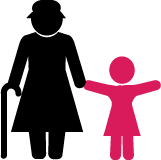Learn More - Evidence

You will learn:
1. The basics of evidence.
2. Questioning witnesses.
3. Presenting exhibits.

1. Evidence Basics
-
Just the Facts
-
The information you give to the Court is called evidence.
You present facts to the Court in a few ways:
- You ask questions to witnesses about what happened.
- You ask questions to witnesses about documents you provide.
- You give your statement about what happened.
-
Within the Rules
-
There are rules to determine if evidence can be considered.
- The Colorado Rules of Evidence guide that process.

2. Witnesses
- Ask Questions at the Hearing
You will ask questions to your witnesses. Some tips:
- Ask open questions.
- Open questions start with who, what, where, when, and why.
- Start with background questions.
- Ask questions, so the Court knows who this witness is and how they know you.
- Let your witness finish answering before asking the next question.
- Ask simple, clear, and precise questions.
- Organize your questions ahead of time.
You also ask questions of the other party's witnesses. Some tips:
- Ask questions to get the witness to support the facts you present. and/or
- Ask questions that may show this witness is less trustworthy.
- This will lessen the impact of facts that do not support your case.
- You can do this by:
- Bring into question the witness's memory.
- Bring into question the witness's truthfulness.
- Show the witness may be biased.
- Show the witness is inconsistent with their story.
- Treat the witness with respect.
- Don't comment on their answer.
- Ask open questions.
- Witness Lists
List out the people you will call at the hearing on a Witness List.
- Provide this list to the Court and the other party with your pre-trial statement.
- Bring copies of the updated list to the hearing.
Note – If you do not provide a witness list before the hearing, you may not be able to call any witnesses.
- Get your Witnesses There
You are responsible for making sure your witnesses are at the hearing.
If a witness doesn't want to come, you can issue a subpoena through the court.
- Take the form to the clerk's office.
- Formally serve (through the sheriff's office or a process server) the subpoena on the witness with the form and a check for their travel expenses.
- You will need to pay the witness $.51 per mile round trip from their location to the Courthouse.
- See the law: C.R.S. § 13-33-103 and C.R.S. § 24-9-104.
- You must have service completed within 48 hours of the hearing date on the subpoena.
- Bring the completed Certificate of Service to the hearing.
- You will need to pay the witness $.51 per mile round trip from their location to the Courthouse.
Witnesses can also just agree to come to the hearing.
- If so, you may not need a subpoena.

3. Exhibits
Common Documents in Family Cases
Review this CLS video for info on:
- Voicemails
- Text Messages & Emails
- Facebook Posts
- Telephone & Financial Records
Organize your Documents
- Exhibit List
List out the documents you plan to present in an Exhibit List.
- Provide the exhibit list, and a copy of all the exhibits, as part of the pre-trial packet of materials.
- Bring copies of the updated exhibit list to the hearing.
- Exhibits not provided before the hearing may not be accepted by the Court.
- Label Exhibits
Assign each document a letter or number.
- Petitioner or Plaintiff generally uses numbers.
- Respondent or Defendant generally uses letters.
Label each exhibit in the lower-right hand corner of the first page.
- When to Present Exhibits
A witness must talk about an exhibit for it to be accepted.
- Know which witnesses will talk about which exhibits.
- Have your exhibits organized for that witness's testimony.

4. A Note on Hearsay